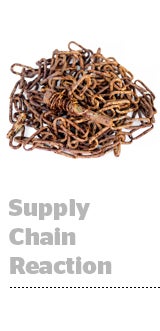 The digital supply chain is a morass and is losing the advertising industry about $8.2 billion a year, according to a joint study released Tuesday by the Interactive Advertising Bureau and Ernst & Young.
The digital supply chain is a morass and is losing the advertising industry about $8.2 billion a year, according to a joint study released Tuesday by the Interactive Advertising Bureau and Ernst & Young.
The price tag includes losses and waste due to piracy, malware and invalid traffic, a trifecta that comprises what EY partner and study lead Nick Terlizzi called the “life cycle of fraud” – the consumption of infringed content that leads to the unintentional downloading of malware that leads to the creation of invalid traffic through botnets. Rinse, repeat.
“Supply chain concerns are jeopardizing the legitimate activities of digital advertising and content businesses,” said Terlizzi during a webcast presentation on the study.
The costliest corruption of the bunch is invalid traffic at $4.6 billion, comprised of fraudulent bot-generated activity, as well as legit nonhuman players, like search engine spiders, competitive intelligence aggregators and brand safety bots.
Media owners also are losing around $2.4 billion from stolen content (pirated music, editorial, video and the like), while malware and malvertising – including compromised third-party scripts intended for measurement – are taking a $1.1 billion bite out of advertisers’ annual budgets.
What should the industry do about it? Work together, for one, said Sherrill Mane, the IAB’s SVP of research, analytics and measurement.
“This is a problem that is shared, not something only the IAB and IAB members can tackle – we need the marketers, we need the agencies … [and we] have to start looking at the various practices across the ecosystem that can unintentionally set off the whole chain of events.”
It’s also about cutting off cash to the bad guys and ceasing to serve ads to sites with infringed content. “Stop providing them with ad revenue because you’re fueling criminal activities,” Terlizzi said.
And then there’s the Trustworthy Accountability Group, which was formed in late 2014 as a cross-industry initiative comprised of the IAB, the Association of National Advertisers (ANA) and the American Association of Advertising Agencies to stamp out fraudulent traffic, combat malware and do away with Internet piracy.
It’s a big job, but it’s not all doom and gloom. Take pirated content. If, say, 21 million people pay $8 a month for access to paid content, that’s a little over $2 billion in subscription revenue right there.
It’s important to note, however, that the IAB’s study, which only focused on the US, was not an audit. Rather, EY’s methodology was a mixture of qualitative and quantitative sources, including data collected from outside measurement and analytics companies to estimate costs, questionnaires filled out by 30 IAB member companies and an aggregation of existing reports on the fraud issue.
Fraud is a hard space to measure accurately and, until recently, the industry didn’t have official numbers to rely on. When the ANA teamed up with White Ops in July 2014, specific fraud benchmarks were thin on the ground.
But bots are tricky little buggers, many of which fly under the radar of detection firms, making it difficult to pin down an exact number. Are You a Human, for example, recently revealed that bots, both good and bad, are still slipping into verified traffic sources for sales on exchanges and through DSPs.
The ANA study ultimately estimated that, left unchecked, malicious botnets would cost advertisers around $6.3 billion. The IAB is now estimating that invalid traffic will be responsible for $4.6 in losses.
As White Ops CEO Michael Tiffany noted to AdExchanger in a recent interview, the bot problem is extremely hard to quantify.
“It’s a moving target made up of other moving targets – swatches of inventory affected by new swatches of infected computers that continually change,” Tiffany said. “The bot operators are a moving target and so are the victims. It’s like an epidemic of bank robberies across the city. It’s not like every robber hits every bank and steals 10% of the money every day. Individual banks can go for long stretches of time and not be a victim – and then all of a sudden, they get hit real hard.”













